Local SEO for Small Businesses: How to Dominate Your Local Market
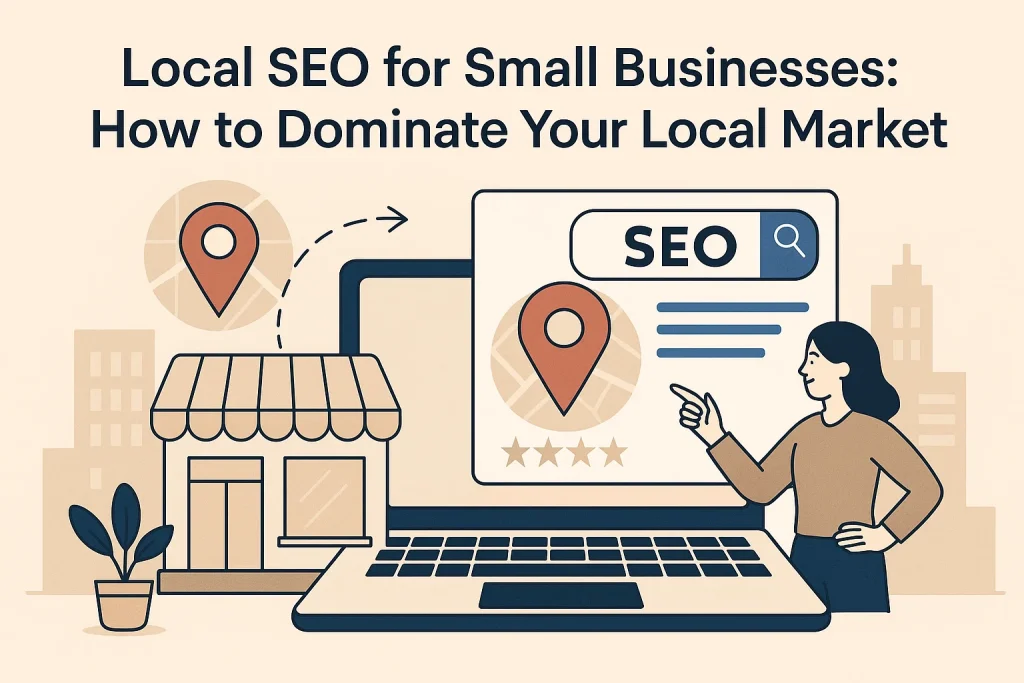
In today’s digital world, local businesses need to prioritize Local SEO to remain competitive and visible to potential customers in their geographic area. As search engines like Google continue to refine their algorithms, local SEO has become a critical factor for small businesses looking to attract customers, drive foot traffic, and increase online conversions. In this blog, we’ll explore Local SEO for small businesses, why it’s crucial , and how you can leverage this strategy to dominate your local market and stand out from competitors. What is Local SEO? Local SEO refers to the process of optimizing your website, content, and online presence so that search engines can easily find your business when users search for products or services in a specific geographic location. Local SEO is especially important for businesses that rely on local customers, such as restaurants, retailers, service providers, and other businesses with physical locations. Why Local SEO Matters for Small Businesses For small businesses, Local SEO is one of the most cost-effective ways to improve visibility and attract new customers. Here’s why it matters: How to Dominate Your Local Market with Local SEO Now that you know why Local SEO is essential, let’s look at the steps you can take to improve your ranking in local searches and dominate your local market. 1. Claim and Optimize Your Google My Business Listing Your Google My Business (GMB) listing is one of the most important elements of local SEO. It directly influences how your business appears in local search results, the Google Local Pack, and Google Maps. Tip: Keep your business hours and information up to date. For example, ensure your hours reflect holidays or special events. 2. Optimize Your Website for Local Keywords Optimizing your website for local keywords ensures that your business appears in search results when people look for products or services in your area. Tip: Avoid keyword stuffing. Use local keywords naturally and contextually to provide value to users. 3. Build Local Citations and NAP Consistency A citation is any online mention of your business, including your Name, Address, and Phone number (NAP). Consistent NAP data across different platforms is a critical ranking factor in local SEO. Tip: Use tools like Moz Local or Yext to check for inconsistencies in your NAP data across the web and correct them. 4. Create Location-Specific Content Creating content that specifically targets local topics, events, or community interests is an excellent way to boost your local SEO. Tip: Create location-specific landing pages if your business operates in multiple areas or cities. This helps target each location more effectively. 5. Encourage and Manage Online Reviews Online reviews are a powerful form of social proof, especially for local businesses. Positive reviews not only influence potential customers but also improve your local SEO rankings. Tip: Don’t focus only on the quantity of reviews—quality matters. Encouraging detailed and thoughtful reviews can make a significant impact. 6. Leverage Local Backlinks Local backlinks from other businesses, media outlets, or community organizations can significantly improve your local SEO performance. Tip: Focus on quality backlinks from reputable local sources rather than simply quantity. Conclusion: Mastering Local SEO to Dominate Your Market Local SEO is a critical aspect of growing your business and ensuring it remains visible to potential customers in your area. By focusing on mobile optimization, local content creation, Google My Business optimization, and maintaining NAP consistency, small businesses can enhance their local presence and dominate their local market. At Speed Dot 360, we specialize in providing tailored Local SEO services that help businesses improve their online presence and attract more customers in their local area. If you’re ready to boost your local visibility and grow your customer base, get in touch with us today to see how we can help. Frequently Asked Questions Q1: What is Local SEO?Local SEO is the process of optimizing your online presence to increase visibility in local search results, making it easier for customers in your area to find your business. Q2: How do I claim my Google My Business listing?You can claim your GMB listing by visiting Google My Business and verifying your business information. Once verified, you can optimize your profile with up-to-date details, photos, and customer reviews. Q3: How do I get more local reviews for my business?Encourage satisfied customers to leave reviews by providing easy access links, offering incentives like discounts, and asking for feedback after transactions. Q4: Why are local backlinks important for Local SEO?Local backlinks signal to search engines that your business is trusted within your community. They help improve your local search rankings and drive traffic to your website. Q5: How do I optimize my website for local SEO?You can optimize your website for local SEO by using local keywords, creating location-specific content, optimizing your GMB listing, and ensuring your website is mobile-friendly.
The Importance of Mobile Optimization in SEO: Why It Matters Now More Than Ever
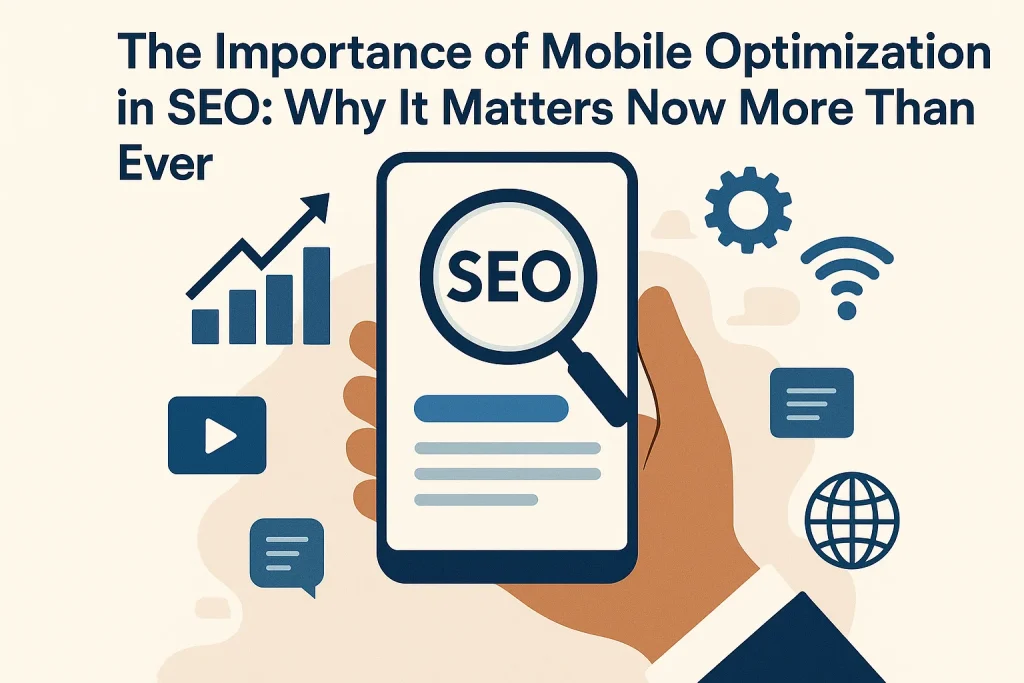
In today’s fast-paced, on-the-go world, mobile devices have become an integral part of our daily lives. Whether browsing the web, shopping online, or accessing social media, consumers are increasingly using smartphones and tablets to perform a wide range of activities. As a result, businesses need to ensure their websites are optimized for mobile devices—not just for user convenience but also to enhance their SEO performance. Mobile optimization in SEO has never been more critical, and in 2025, it is one of the most important factors influencing search engine rankings. Google’s shift toward mobile-first indexing, the rapid rise in mobile searches, and the need to meet consumer expectations are all reasons why mobile optimization is paramount for any business that wants to succeed online. In this blog, we’ll discuss why mobile optimization matters for SEO, how it impacts your rankings, and actionable steps you can take to improve your website’s mobile-friendliness. What Is Mobile Optimization? Mobile optimization refers to the practice of designing and developing a website so that it provides the best user experience on mobile devices, such as smartphones and tablets. A mobile-optimized website loads quickly, displays correctly, and offers easy navigation on smaller screens, ensuring visitors can easily interact with your site. Mobile optimization involves: Why Mobile Optimization Matters for SEO Mobile optimization plays a significant role in improving both user experience and search engine rankings. Here’s why it matters now more than ever: 1. Google’s Mobile-First Indexing Google uses mobile-first indexing, meaning it predominantly uses the mobile version of your website to rank your pages and understand content. Previously, Google used desktop versions of websites to assess content, but this shift to mobile-first indexing reflects the growing dominance of mobile browsing. 2. The Rise of Mobile Searches In 2025, mobile searches are expected to account for more than 70% of total online searches. With smartphones in hand, people are using voice search, browsing social media, and conducting product searches at unprecedented rates. 3. User Experience (UX) and Mobile Optimization Go Hand-in-Hand User experience is one of the most important factors in SEO today, and mobile optimization is crucial to providing a positive experience. A seamless mobile experience means users can easily navigate your site, find information, and complete their goals—whether it’s making a purchase, filling out a form, or reading your blog. 4. Faster Load Times and Better Rankings Page load speed is a critical aspect of mobile optimization. Slow-loading websites result in higher bounce rates, decreased time on site, and frustrated users. Google has clearly stated that page speed is a ranking factor, and with mobile users demanding instant access, slow sites risk losing visitors and ranking lower. 5. Impact on Local SEO Mobile optimization is particularly important for local SEO, especially as mobile devices are often used for on-the-go searches like “near me” queries. When people search for businesses or services nearby, Google delivers local search results based on the user’s location, and mobile optimization plays a key role in these results. Best Practices for Mobile Optimization in SEO Here are some best practices to ensure your website is fully optimized for mobile and ready for SEO success: Conclusion: Why Mobile Optimization is Non-Negotiable for SEO in 2025 In 2025, mobile optimization is not just a nice-to-have feature; it’s a necessity for businesses that want to thrive in search rankings and provide exceptional user experiences. With Google’s mobile-first indexing, the explosion of mobile searches, and the growing importance of user experience, businesses that fail to optimize for mobile are at risk of losing visibility, traffic, and revenue. At Speed Dot 360, we understand the importance of mobile optimization in today’s digital landscape. Our expertise in web development and SEO strategies helps businesses ensure their websites are not only mobile-friendly but also optimized for top performance across all devices. If you’re looking to improve your website’s mobile optimization and boost your SEO rankings, contact us today to start creating a seamless, mobile-friendly experience for your audience. FAQ Section Q1: How can I test if my website is mobile-optimized?Use Google’s Mobile-Friendly Test tool to check if your website is optimized for mobile devices. This tool will provide a detailed report on what aspects need improvement. Q2: Can mobile optimization affect my Google rankings?Yes, mobile optimization plays a key role in your website’s SEO. Google uses mobile-first indexing, meaning it primarily uses the mobile version of your website to rank it in search results. Q3: What is the best way to improve mobile load times?You can improve mobile load times by optimizing images, reducing JavaScript and CSS files, using lazy loading for images, and leveraging a Content Delivery Network (CDN). Q4: Is mobile optimization important for e-commerce websites?Absolutely. Mobile optimization is critical for e-commerce websites since many customers browse and make purchases on mobile devices. A slow or poorly optimized mobile site can lead to lost sales and decreased customer satisfaction. Q5: How can I optimize my website for voice search?Focus on using natural language, long-tail keywords, and question-based phrases in your content. Ensure that your website is mobile-friendly, as many voice searches are conducted via mobile devices.
10 Proven Strategies for Building High Quality Backlinks
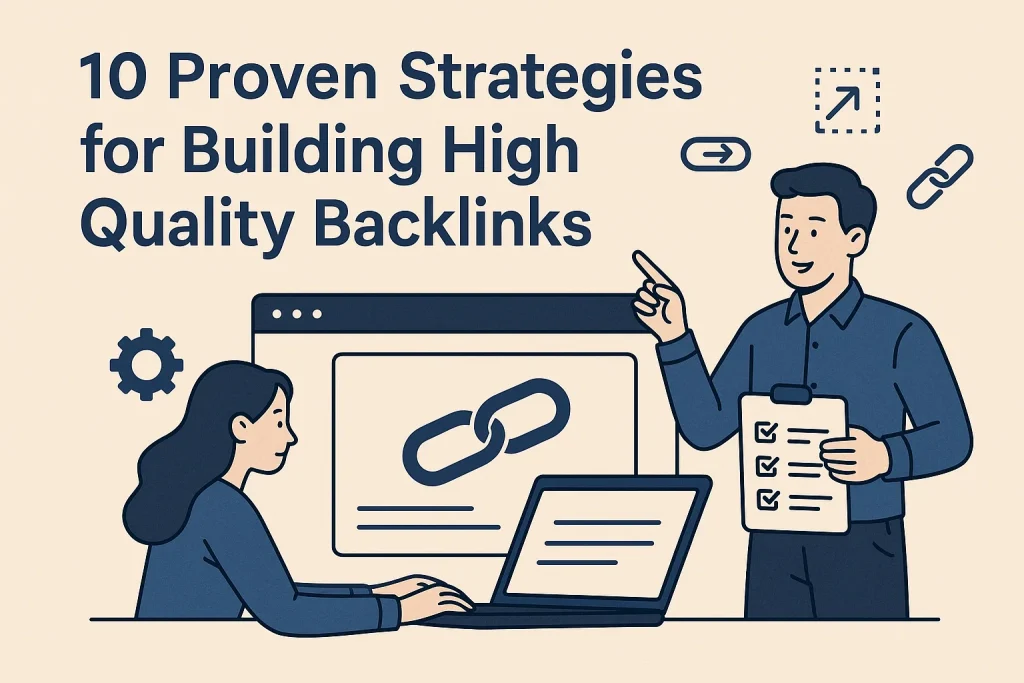
Backlinks are one of the most powerful elements of SEO. When search engines like Google see that other reputable websites are linking to your content, they interpret it as a sign of trust and authority. As a result, your website’s ranking on search engine results pages (SERPs) improves. However, not all backlinks are created equal. Quality backlinks from authoritative, relevant sources are far more beneficial than a large quantity of low-quality links. In this blog, we’ll explore 10 proven strategies for building high-quality backlinks that can significantly enhance your SEO efforts and help you climb the ranks in search engines. 1. Create High-Quality, Shareable Content Content is at the core of every successful backlink strategy. The more valuable and engaging your content is, the more likely others will want to link to it. Content that provides useful information, solves problems, or answers questions tends to attract backlinks naturally. Tip: The more informative, unique, and well-designed your content is, the more it’s likely to be shared and linked to by others. 2. Guest Posting on Relevant Websites Guest posting is one of the most effective ways to build backlinks, particularly if you’re looking to gain high-quality, authoritative links. By writing high-quality guest posts for reputable websites in your niche, you can secure backlinks while simultaneously increasing your visibility. Tip: Always ensure that the guest post aligns with your brand’s values and target audience. This makes the backlink more relevant and valuable. 3. Broken Link Building Broken link building is a strategy where you find broken links (404 errors) on other websites and suggest your content as a replacement. This helps webmasters fix their broken links while providing you with an opportunity to secure a high-quality backlink. Tip: Make sure the content you’re suggesting as a replacement is high-quality and relevant to the page. A well-crafted, thoughtful email to the website owner can increase your chances of earning the link. 4. Leverage Influencer Outreach Influencer marketing isn’t just for product promotions—it can also be an excellent tool for building backlinks. By connecting with influencers and industry leaders in your niche, you can encourage them to mention or link to your content in their blogs, articles, or social media posts. Tip: Approach influencers with personalized and thoughtful outreach. Offer them something of value in return, like sharing their content or collaborating on a project. 5. Resource Page Link Building Many websites feature resource pages that link to valuable tools, content, or industry-specific resources. By identifying these resource pages and getting your content listed, you can earn valuable backlinks from trusted websites. Tip: Ensure your content is truly valuable and unique before reaching out to resource pages. If it’s not helpful to the page’s audience, your request may be denied. 6. Build Relationships with Other Bloggers Building relationships within your industry can lead to mutual backlinking opportunities. Engaging with other bloggers and content creators in your field can result in them linking to your content, either through collaborations or casual mentions. Tip: Relationships take time to build, so focus on offering value to others in your industry before asking for backlinks. 7. Submit Your Website to Online Directories Submitting your website to reputable, niche-specific online directories can help improve your backlink profile and drive targeted traffic to your website. However, it’s important to focus on high-quality, trustworthy directories, as low-quality directories can harm your SEO. Tip: Include complete and accurate business information in your directory submission, and ensure it aligns with your overall SEO strategy. 8. Participate in Industry Forums and Communities Participating in industry-specific forums, online communities, and Q&A platforms like Quora can help you build backlinks and establish yourself as an authority in your niche. When you share insights, answer questions, and contribute to discussions, you can include backlinks to your site. Tip: Don’t overdo the self-promotion—focus on building credibility and providing value, and the backlinks will come naturally. 9. Conduct Expert Roundups Expert roundups are blog posts that feature insights from multiple experts in a particular industry. These roundups are often highly shareable and attract backlinks from the experts featured in the post. Tip: Make sure to reach out to industry leaders who have an engaged following and a strong online presence. Their backlink will carry more weight. 10. Use Social Media for Link Building While social media backlinks are typically no-follow (they don’t directly impact SEO), they can still generate referral traffic, increase brand visibility, and lead to earned backlinks from authoritative sources. Tip: Make your content shareable by adding social sharing buttons and promoting it across multiple platforms to increase its reach and backlink potential. Conclusion Building high-quality backlinks is one of the most effective SEO strategies for improving your website’s authority and search engine rankings. While it requires time and effort, implementing these 10 proven link building strategies can help you create a solid backlink profile that boosts your visibility, drives organic traffic, and establishes your website as a credible authority in your niche. At Speed Dot 360, we specialize in professional link building services that help businesses earn high-quality backlinks from authoritative sources. If you’re ready to enhance your SEO and dominate your industry, get in touch with us today to learn more about our proven strategies. Frequently Asked Questions Q1: How long does it take to see results from link building?Link building efforts can take several weeks to a few months to show measurable results, depending on the quality of the backlinks and the competition in your industry. Q2: What is the difference between a do-follow and a no-follow backlink?A do-follow backlink passes on SEO value (link juice) to the linked page, improving its search engine rankings, while a no-follow backlink does not pass on link equity but can still drive traffic and help with brand visibility. Q3: Can I build backlinks myself, or should I hire a professional?While you can build backlinks on your own, working with a professional link building service can help you acquire high-quality backlinks more efficiently and avoid penalties from
How Link Building Services Can Help You Dominate Your Niche Market

In today’s competitive digital landscape, standing out in your niche market is essential for success. Whether you’re in a highly competitive industry or a niche market, effective SEO practices are necessary to achieve long-term growth. One of the most powerful and often overlooked strategies for boosting your SEO is link building. Backlinks, or inbound links, are critical to improving your site’s authority, search engine rankings, and online visibility. If you’re wondering how link building services can help you dominate your niche market, this blog will explore the vital role of backlinks in driving organic traffic and positioning your website at the top of search engine results. What Is Link Building and Why Is It Important? Link building is the process of acquiring backlinks from other websites to your own. These links act as “votes of confidence” in your site’s content, signaling to search engines like Google that your content is valuable and trustworthy. In simple terms, the more authoritative and relevant sites that link to you, the more likely you are to improve your rankings and visibility on search engines. For niche markets, link building can be a game-changer. Unlike broad industries, niche markets often face the challenge of competing with a smaller pool of competitors. With the right link building strategy, you can significantly increase your site’s visibility within that smaller pool, gaining an advantage over competitors who are not utilizing these strategies effectively. How Link Building Helps You Dominate Your Niche Market Here’s how link building services can directly benefit your business and help you stand out in your niche market: 1. Establishing Authority in Your Niche Backlinks from reputable and relevant websites are a clear signal to search engines that your website is an authoritative source within your niche. In niche markets, where businesses typically operate in a specialized field, link building is particularly effective for signaling expertise. By securing backlinks from authoritative sources within your industry, such as influential blogs, industry publications, or experts, you build a reputation as a trusted authority in your niche. As search engines like Google consider these backlinks as votes of confidence, they improve your website’s domain authority, increasing your visibility in niche-specific search results. Tip: Focus on earning backlinks from websites and publications directly relevant to your niche, as these will be seen as more valuable than general backlinks. 2. Improving SEO Rankings for Niche Keywords One of the primary benefits of link building services is improving your rankings for niche-specific keywords. Ranking high for highly competitive general keywords is challenging, but ranking for long-tail, niche-specific keywords is more achievable with a solid backlink strategy. When you acquire backlinks from high-quality sources within your niche, these backlinks directly impact your ability to rank for relevant niche keywords. As search engines view your site as an authoritative resource, they reward you with higher rankings for keywords that specifically target your niche. Tip: Target low-competition, high-intent long-tail keywords related to your niche, and focus on getting backlinks from sites that are relevant to these topics. 3. Generating Quality Traffic from Relevant Sources Link building is not just about improving rankings—it’s also about driving quality traffic to your website. Backlinks from reputable sites don’t just help with SEO; they also drive targeted traffic from visitors who are genuinely interested in your niche offerings. When you acquire backlinks from authoritative and relevant websites, you’re essentially tapping into their established audience. This means that visitors from these sites are more likely to find your content valuable and convert into potential customers. Tip: Make sure the content linked to your website provides clear, valuable, and relevant information that resonates with the audience of the referring site. The more value you offer, the more likely users are to click through and engage with your site. 4. Building Relationships and Collaboration Opportunities Link building services are not just about acquiring links—they also help you build meaningful relationships with other businesses, influencers, and industry leaders in your niche. Collaborating with other content creators, bloggers, and thought leaders in your field can help increase your reach and establish you as a key player in your niche market. When you create content that earns backlinks from influential figures within your industry, you create opportunities for further collaborations, partnerships, or guest blogging opportunities. These collaborations can help you extend your network, reach a broader audience, and gain further backlinks in the process. Tip: Focus on relationship-building rather than just link acquisition. A mutually beneficial relationship with niche influencers can open up multiple opportunities for long-term business growth. 5. Enhancing Local SEO for Niche Markets Link building services also play a crucial role in local SEO, which is especially important for small businesses targeting a specific geographic area. When you build backlinks from local business directories, local blogs, or websites that focus on a specific city or region, it helps boost your rankings in local search results. For small businesses in niche markets, local SEO is often the most effective way to increase visibility within a specific geographic area. By acquiring backlinks from local businesses, media outlets, and community-based organizations, you can improve your site’s local relevance and drive traffic from local customers who are actively seeking your niche products or services. Tip: Ensure your business is listed in local business directories and collaborate with other local businesses to build a strong local backlink profile. 6. Expanding Brand Awareness and Recognition Link building services not only help with SEO but also play a role in increasing brand awareness. Each backlink you acquire is an opportunity for new customers to discover your brand. When your website is linked to from a variety of reputable sources, you increase the visibility of your brand and get in front of an audience that may not have heard of you otherwise. Tip: Actively participate in niche online communities, such as forums, podcasts, or webinars, to build backlinks while simultaneously increasing your brand’s visibility and reach. Conclusion Link building services are an essential part of dominating your niche
Understanding the Power of Backlinks in SEO and How to Build Them
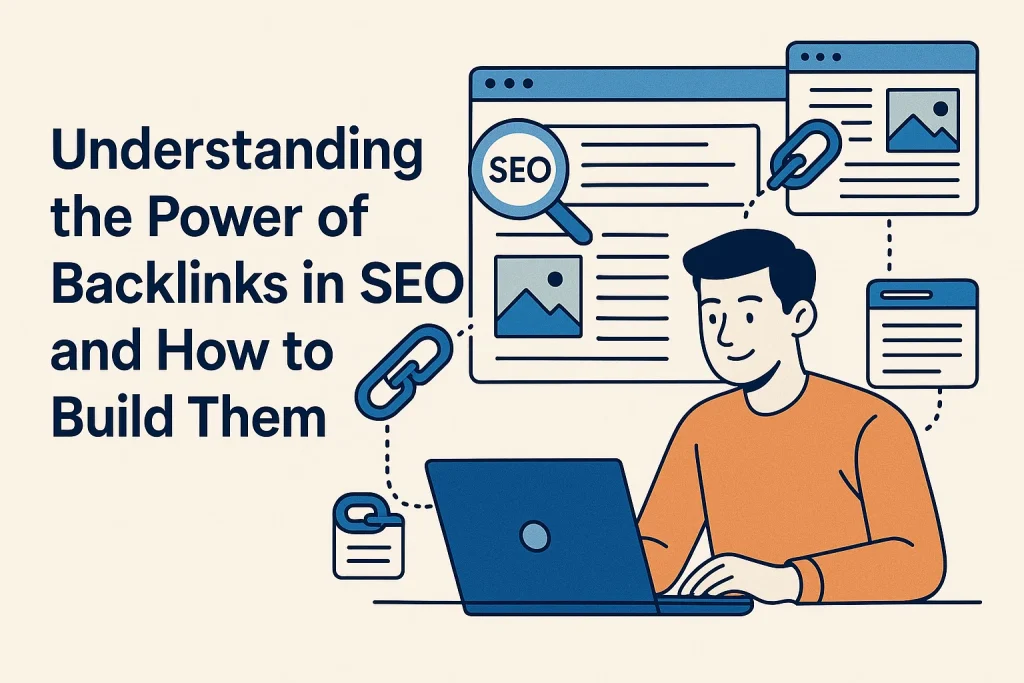
In the ever-evolving world of search engine optimization (SEO), backlinks remain one of the most influential factors for improving website rankings. But what exactly are backlinks, and why are they so critical to SEO? In this blog, we’ll explore the power of backlinks in SEO, how they impact, and the most effective strategies for building them. What Are Backlinks? A backlink is a hyperlink on another website that points to your site. They’re also referred to as inbound links or incoming links. Search engines like Google consider backlinks as a signal of trust and authority. In simple terms, when a reputable website links to your content, it’s like they’re vouching for your credibility. Backlinks are an essential aspect of SEO because search engines, particularly Google, use them as a ranking factor to determine how valuable or authoritative your website is. The more quality backlinks you have, the more likely you are to rank higher in search engine results pages (SERPs). Why Are Backlinks Important for SEO? Backlinks are often compared to “votes of confidence” for your website. Here’s why they’re so valuable in SEO: The Different Types of Backlinks Not all backlinks are created equal. There are various types of backlinks, and understanding the differences can help you focus on the right kind: How to Build Backlinks in SEO: Strategies for Success Building high-quality backlinks requires a strategic approach. Below are some effective methods to help you acquire backlinks that will boost your website’s SEO: 1. Create High-Quality, Shareable Content The foundation of any successful backlink strategy is content. If your content is valuable, informative, and shareable, other websites are more likely to link to it. Creating content that answers specific questions or provides unique insights will make it stand out. Tip: The more useful and shareable your content is, the more likely others will link to it. 2. Guest Posting Guest posting remains one of the most effective ways to build backlinks. By writing articles for other blogs in your niche, you can insert a backlink to your website within the content or author bio. Tip: In your guest post, make sure the content adds value and aligns with the host site’s audience to increase the chances of your link being included. 3. Leverage Broken Link Building Broken link building is a technique where you find broken links (404 errors) on other websites and offer your own relevant content as a replacement. This not only helps improve the user experience on the linking site but also gives you an opportunity to earn a backlink. Tip: Ensure your content is highly relevant to the page that is linking out to improve the chances of getting the replacement link. 4. Engage in Influencer Outreach Influencer marketing is not just about promoting products—it’s also about building relationships with influencers who can help promote your content. Reaching out to influencers in your industry and asking them to share your content or provide a backlink can be a highly effective strategy. Tip: Focus on micro-influencers or niche experts, as their audience is likely to be more engaged and relevant to your content. 5. Participate in Online Communities Online communities such as forums, Facebook groups, Reddit, or niche-specific websites can be excellent places to earn backlinks. By engaging with these communities, answering questions, and sharing valuable resources, you can gain natural backlinks. Tip: Avoid spamming forums or groups with irrelevant links. Focus on offering genuine insights that naturally incorporate links to your content. 6. Collaborate with Other Websites Collaborating with other businesses or content creators in your industry can lead to mutually beneficial backlinking opportunities. For example, co-hosting webinars, creating joint content, or working on shared projects can naturally lead to backlinks from the collaborating sites. Tip: Look for collaborations that are aligned with your business goals and target audience to maximize the value of backlinks. Best Practices for Backlink Building Conclusion Backlinks remain one of the most powerful SEO factors for ranking on search engines. Understanding the power of backlinks and implementing effective strategies to build them is essential for improving your website’s visibility, credibility, and overall SEO performance. At Speed Dot 360, we specialize in helping businesses with SEO services that drive organic traffic, improve rankings, and increase brand authority. Whether you’re just starting your website’s SEO or looking to improve your rankings, we can help you in every step of the process. Frequently Asked Questions Q1: What is a high-quality backlink?A high-quality backlink comes from a reputable, authoritative website in your industry. It provides value to the user and is relevant to the content it’s linking to. Q2: How many backlinks do I need to rank higher in Google?There’s no magic number. The quality, relevance, and authority of the backlinks matter more than the quantity. Focus on getting backlinks from reputable sources in your niche. Q3: Can I buy backlinks to improve my SEO?Buying backlinks is a risky strategy. Google’s algorithm detects unnatural link-building tactics, and purchasing backlinks can lead to penalties that negatively impact your rankings. Q4: How long does it take to see results from backlinks?It can take a few weeks to a few months for backlinks to show results, depending on the authority of the linking website and the competitiveness of the keywords you’re targeting. Q5: Should I focus on no-follow backlinks?While do-follow backlinks are more powerful for SEO, no-follow links can still drive referral traffic and enhance your backlink profile’s diversity. It’s important to have a mix of both.
Using Video to Boost Your Website Rank: Tips for 2025

In the competitive world of 2025, search engine optimization (SEO) is a necessity for any business that wants to succeed online. With dozens of sites, competing for attention, it can be difficult to stand out. However, one highly effective tool that can help boost your website rank and holds even more potential in the future is video content. In today’s digital landscape, video is a critical factor that empowers you to engage users and improve website rankings on search engines. Google’s algorithms prioritize websites with high user engagement, and video plays a significant role in increasing dwell time, click-through rates, and social shares. Not only do videos improve user experience, but they also help improve SEO metrics that matter most to search engines. In this blog post, we’ll explore how video content impacts SEO, provide expert tips on how to optimize video for SEO, and discuss how SpeedDot360 can help your business make the most out of video content for SEO. The Growing Importance of Video in SEO The rise of video content is undeniable. By 2025, video is expected to be the primary reason for 82% of the entire internet traffic. With such a significant shift in user behavior, Google has not only adapted but also prioritized video content in its ranking algorithms. Websites with optimized video content are more likely to rank well on search engines, a testament to the adaptability of Google’s algorithms. But why is video so essential for SEO? The main reason is its ability to influence key user engagement metrics that directly impact your website’s SEO ranking: How Video Content Boosts SEO Metrics When implemented effectively, video content can have a profound impact on several important SEO metrics. Here’s a closer look at the most significant ways video helps your SEO strategy: 1. Improved Dwell Time Videos keep users on your website longer. When a user watches a video, they are more likely to engage with other content, increasing the amount of time they spend on your page. Google sees this as a positive signal that your content is engaging and relevant. 2. Increased Click-Through Rates (CTR) Incorporating video into your search results, whether on Google or YouTube, increases your chances of getting clicked. A video thumbnail in search results naturally draws the eye, encouraging more clicks. Higher CTR is an essential ranking factor, so adding videos can help your content rank higher and attract more traffic. 3. Backlinks and Social Shares Video content is more likely to be shared on social media, which can generate backlinks to your website. Google values backlinks, as they show that other reputable sources trust your content. 4. Rich Snippets and Featured Snippets Optimized video content can appear as a rich snippet or featured snippet on search engine results pages (SERPs). Featured snippets are prime real estate on Google, often showing up at the very top of the search results. This increased visibility can drive more traffic to your website. 5. Mobile-Friendly Content Video is particularly effective for mobile users. Mobile traffic accounts for more than half of all web traffic, and videos are easier to consume on mobile devices than long-form text. Mobile-optimized videos enhance user experience and help your website rank higher in mobile searches. Tips for Using Video to Boost SEO in 2025 To leverage video content for SEO effectively, follow these best practices for video optimization: 1. Optimize Video Titles and Descriptions with Keywords Just like any other type of content, video titles and descriptions are essential for SEO. Keyword optimization in your video title and description helps search engines understand what your video is about, making it easier for Google to index and rank your video. Be sure to include relevant keywords and phrases that users are likely to search for. For example, suppose your business focuses on SEO services. In that case, you might title your video “How Video SEO Can Boost Your Website’s Ranking in 2025” and include a detailed description with SEO-related keywords. 2. Add Transcripts for Better Indexing Search engines cannot watch videos, but they can easily read text. Adding video transcripts helps search engines understand the content of your video, allowing them to index it for relevant search queries. Transcripts provide valuable text content that improves SEO by allowing Google to crawl the video more effectively. 3. Implement Video Schema Markup Infusing video schema markup into your video content is a must for helping Google understand your video’s context. Schema markup provides structured data that tells Google details about your video, including its title, description, and duration. Videos with schema markup are more likely to appear in rich snippets or featured snippets, making them stand out in search results. SpeedDot360 specializes in integrating video schema markup, ensuring that your videos are fully optimized for SEO and have the best chance of ranking higher. 4. Ensure Mobile Optimization Video content must be optimized for mobile users. Mobile traffic is now dominant, and videos need to load quickly and play smoothly on smaller screens. Use responsive video embeds and ensure that your videos are formatted for mobile viewing. 5. Promote Videos on Social Media Social media is a superb way for your video promotion. Sharing videos across platforms like Facebook, Instagram, LinkedIn, and Twitter can drive traffic back to your website and improve SEO. Social signals such as likes, shares & comments impact your SEO by improving your video’s visibility & increasing more engagement. SpeedDot360 can assist in promoting your videos across multiple social media channels, helping to maximize video exposure and boost your SEO. 6. Create Evergreen Video Content Evergreen content is the one that remains super relevant over time. By creating evergreen video content, you ensure that your videos continue to attract traffic long after they’ve been published. Examples of evergreen video content include tutorials, product demos, and how-to guides, all of which can continue to rank well and generate traffic for years. SpeedDot360 has mastered in producing evergreen video content, providing long-term value to businesses. 7.
Generative Engine Optimization (GEO): Ensuring Your Brand is Cited by AI

As generative AI tools become mainstream, businesses face a new challenge: ensuring their brand appears when AI systems like ChatGPT, Google Gemini, and other large language models (LLMs) generate content. The old rules of search engine optimization (SEO) are no longer enough because search engines are no longer the only way people get information. Today, Generative Engine Optimization (GEO) is emerging as the next big thing in digital marketing, helping brands secure visibility in AI-generated summaries, answers, and content recommendations. This guide explores everything businesses need to know about GEO—what it is, why it matters, and the practical steps you can take to ensure your brand is cited when AI delivers results to users worldwide. What is Generative Engine Optimization (GEO)? Generative Engine Optimization, or GEO, refers to optimizing content so that generative AI systems recognize, trust, and reference it when producing answers or creating content. Unlike typical SEO, which targets the ranking in search results, GEO plans to build topical authority, AI-centric signals and structured content, allowing AI modes to: In simple terms, while SEO gets you visibility on Google or Bing, GEO helps your brand stay visible in the AI-powered digital future. Why GEO Matters in 2025 and Beyond The digital landscape is evolving fast. Millions of people now rely on AI-powered assistants for product recommendations, research, and answers to everyday questions. That means: Ignoring GEO today might be the same as neglecting SEO in the early 2000s—a missed opportunity that competitors will capitalize on. Key Strategies for Effective Generative Engine Optimization To make GEO successful, you need to adapt strategies designed for AI-powered methods rather than just search engines. Let’s go through the following significant steps: 1. Use llms.txt to Guide AI Models Just as sites use robots.txt to guide search engines, LLMs.txt files are made to communicate with the large language models (LLMs). By generating this file, you can: Adding an llms.txt file ensures AI tools understand your brand’s content structure and citation policies. 2. Implement AI-Friendly Metadata Metadata is information embedded in your content that helps search engines and AI models understand context. For GEO, you need to: This makes it easier for AI tools to recognize your content as authoritative and reliable. 3. Structured Data and Schema Markup Generative AI systems prefer structured, organized information. Schema markup guides AI about the specific meaning of your content, not just what it reveals. For instance: The more context you ensure, the easier it is for AI to reference your brand perfectly. 4. Build Clear Topical Authority AI tools rely on credible sources when it is to create answers. To become one: When AI sees your brand as a trusted expert in a particular subject area, it is likelier to cite you in responses. 5. Create AI-Friendly Content Formats Generative AI prefers concise, well-structured information. That means: The easier it is for AI to read your content, the more likely it will appear in AI-generated answers. 6. Monitor AI Citations and Mentions GEO doesn’t end with publishing content—you need to track when and how AI tools reference your brand. This data helps you fine-tune your content strategy. Future Trends in Generative Engine Optimization The field of GEO is still new, but here’s what we can expect in the coming years: How Businesses Can Get Started with GEO If you’re new to Generative Engine Optimization, here’s a roadmap: Conclusion Generative Engine Optimization isn’t just a passing trend—it’s the future of digital visibility. As AI tools increasingly shape how users find information, businesses that optimize for AI citations and discoverability will have a significant competitive advantage. By implementing llms.txt, using structured data, building topical authority, and publishing AI-friendly content, your brand can stay ahead in the evolving digital era. FAQs 1. How is GEO different from traditional SEO?GEO optimizes content for AI-generated results, while SEO is all about improving a ranking in search results on all the search engines. 2. Do all businesses need to adopt GEO strategies?Yes, especially brands that rely on digital visibility for leads, sales, or thought leadership should start investing in GEO. 3. What is llms.txt, and why is it important?llms.txt is a file that communicates with AI models, telling them how to access and cite your content. 4. How soon will GEO become mainstream?With the rapid adoption of AI tools in 2025, GEO is expected to become a core part of digital marketing within the next 1–2 years.5. Can GEO improve website traffic directly?Indirectly, yes. If AI tools consistently mention your brand, users will search for you directly or visit your site after seeing your brand cited as an authority.
Gen AI’s 165x Faster Growth Over Organic Signals a Shift in Search.
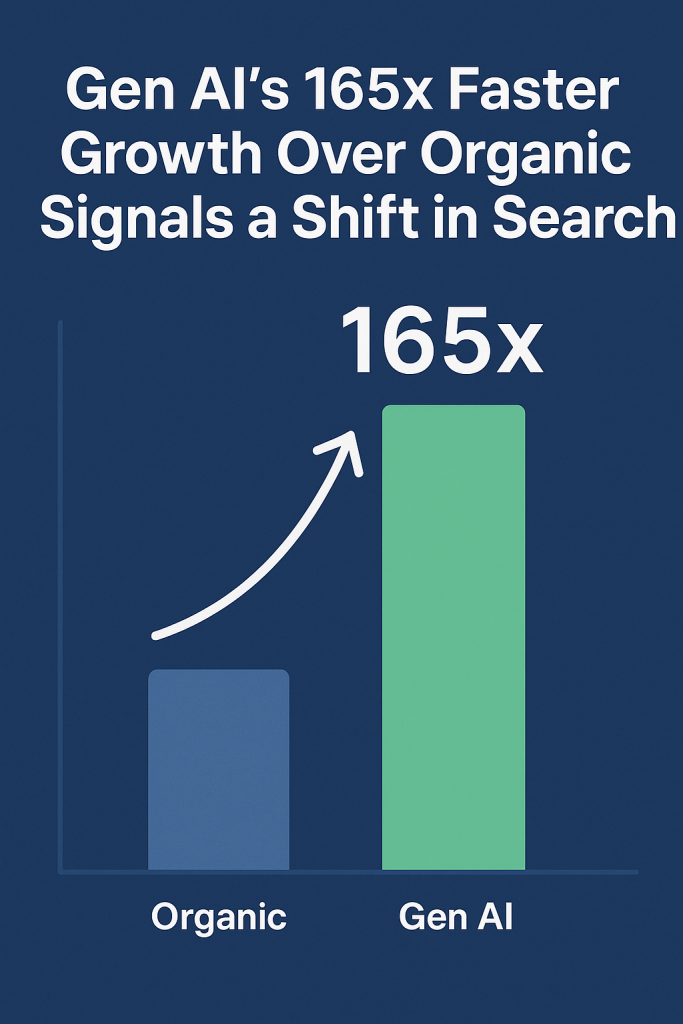
In the constantly evolving digital marketing ecosystem, few shifts have been as rapid—and as dramatic—as the meteoric rise of generative AI in online search behavior. According to recent industry analysis, Gen AI traffic is growing 165 times faster than organic search, signaling not just an emerging trend but a seismic shift in how users discover, evaluate, and interact with content. This isn’t a story about the demise of traditional SEO, far from it. Instead, it underscores the urgency of adopting an adaptive, holistic strategy that blends traditional methods with artificial intelligence solutions to stay ahead of the curve. At Speed Dot 360, we’ve always believed in staying one step ahead—and this new wave of AI-driven search discovery proves why that mindset is more crucial than ever. Gen AI’s Meteoric Growth: A 165x Surge The WebFX study tracking over 1 billion search sessions across 1,500 businesses revealed a stunning insight: generative AI is growing 165x faster than organic search. While AI-driven search still represents a smaller percentage of overall traffic (currently less than 1%), its trajectory suggests it’s on course to become a major discovery channel in the near future. What’s fueling this acceleration? For businesses, this shift means it’s no longer enough to dominate Google’s SERPs—you now need to show up across multiple digital touchpoints, many of which are powered by AI. AI vs. Organic: Quantity vs. Quality? While organic search continues to deliver the lion’s share of web traffic (31.09%), Gen AI is punching above its weight in terms of user engagement and conversion rate. That means businesses targeting these users with the right content can yield disproportionately higher returns—especially when AI is leveraged as part of a comprehensive artificial intelligence solution. Search Is No Longer Just “Search”: The Rise of AI Ecosystems Another revelation from the data is the diversification of platforms contributing to AI search traffic. Here’s a quick look at the top players: Platform Share of Gen AI Sessions ChatGPT 60.6% Perplexity 26.2% Google Gemini 9.8% Microsoft Copilot 3.4% Takeaway: It’s not just about optimizing for Google anymore. Brands must now assess where their audience engages—whether in conversational queries on ChatGPT, research-driven answers from Perplexity, or integrated browsing experiences in Gemini—and tailor their content strategies accordingly. Which Industries Are Leading in Gen AI Adoption? Some sectors are already leveraging Gen AI’s growth, with retail, healthcare, hospitality, and ecommerce leading in AI-driven traffic acceleration: Industry Month-Over-Month Growth in Gen AI Sessions Retail Storefronts 47.11% Leisure & Hospitality 32.52% Healthcare 30.60% Ecommerce 30.28% Construction 29.19% These sectors are characterized by consumer trust, price comparison, and rapid information access—all of which Gen AI tools excel at facilitating. If your business operates in one of these industries, your AI strategy needs to be more than an afterthought—it should be central to your digital roadmap. OmniSEO™: A Framework for the New Search Era To compete effectively in today’s multifaceted landscape, WebFX recommends an OmniSEO™ approach: a multi-channel, AI-inclusive strategy that ensures your brand shows up everywhere your audience searches. What does OmniSEO™ involve? By embracing an OmniSEO™ strategy, businesses can maximize both volume and quality—drawing high-converting AI traffic without sacrificing traditional search authority. How to Optimize for Gen AI Discovery So, how do you make sure your brand is discoverable in this fast-changing environment? 1. Test Your Brand in AI Platforms Type customer-centric questions into ChatGPT, Gemini, or Perplexity. Does your brand show up? If not, look at who does—and reverse-engineer their content. 2. Close AI Content Gaps Study the answers AI tools give about your industry or niche. If they lean on general blogs or outdated info, there’s an opportunity to create focused, factual, AI-optimized content. 3. Optimize with Schema Markup Use structured data (like FAQs, How-To, and Product) to help AI tools better understand and extract your content. 4. Build Content That Helps AI engines prioritize action-focused tools like: These elements not only serve human readers but also increase your visibility in AI-generated results. 5. Track, Adjust, Repeat Keep tabs on referral data, time-on-page, and search appearance. AI is evolving, and so must your approach. The Strategic Role of Artificial Intelligence Solutions At Speed Dot 360, we’ve seen firsthand how artificial intelligence solutions can empower brands to: Whether it’s through AI-powered keyword clustering, predictive analytics, or conversational AI integrations, these tools give you the agility to adapt as fast as the search landscape changes. Final Thoughts: The Future Is Omni, Not Either-Or Generative AI’s 165x faster growth is not a threat to organic search—it’s an evolution of how people ask, engage, and decide. Yes, traditional search remains powerful. But ignoring Gen AI’s momentum is a mistake businesses can’t afford to make. It’s no longer about whether to optimize for AI or SEO. It’s about doing both, strategically and simultaneously. Embracing artificial intelligence solutions is the only way to remain discoverable, relevant, and competitive in this new digital frontier.
Shopify And WooCommerce in 2025: What’s Best for Growing Your Online Store?
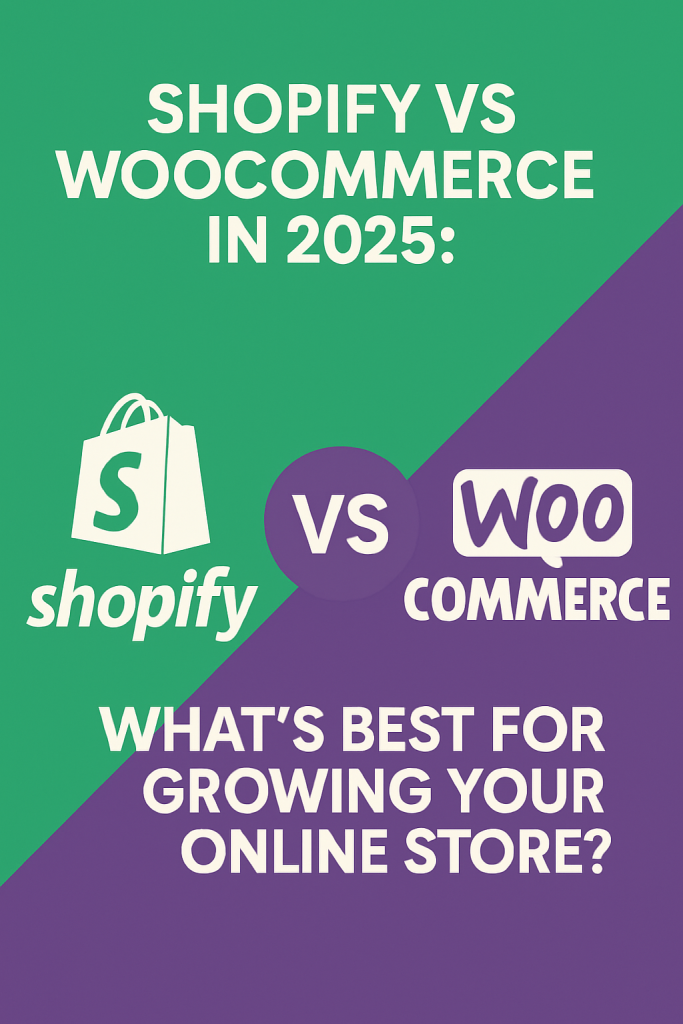
Selecting the right ecommerce platform can either make or break your online business. Shopify and WooCommerce remain two of the most powerful contenders, but their suitability depends on your business model, growth goals, and technical requirements. This article compares both platforms as we move into 2025, factoring in cost, SEO, customization, and more. Shopify: All-in-One Simplicity Shopify is known for its ease of use, fast setup, and comprehensive support. It’s a hosted platform, meaning you don’t have to worry about hosting, security, or updates—it’s all managed for you. Pros: Cons: WooCommerce: Flexibility and Control WooCommerce is an open-source WordPress plugin that gives you full control over your website. It’s best suited for those who need custom ecommerce solutions or already use WordPress for content management. Pros: Cons: SEO and Performance Comparison WooCommerce SEO Strengths Shopify SEO Strengths Payment Gateways and Checkout Experience Shopify supports 100+ payment gateway integration options and offers a smooth, fast checkout experience that is well-optimized for conversions. WooCommerce supports many gateways, too, but the checkout process may need additional customization to be seamless. Notable Features: Marketing Tools and Integrations Shopify WooCommerce Customization & Design Freedom WooCommerce is more flexible because it’s open-source. Developers can customize every aspect of the site. Shopify is easier for beginners but may feel restrictive for advanced design changes. Real-World Use Cases Cost Comparison Over Time Shopify plans range from $39 to $399 per month. Additional costs come from apps, themes, and transaction fees. WooCommerce itself is free, but domain, hosting, premium themes, and plugins can accumulate expenses quickly. Long-Term Costs Breakdown: Cost Area Shopify (Monthly) WooCommerce (Variable) Platform $39 – $399 $0 Hosting Included $5 – $30/month Plugins/Apps $0 – $100+/mo $0 – $200+ (yearly) Maintenance Minimal Requires developer/admin User Experience and Performance Metrics Case Study: Speed Dot 360 Ecommerce Client A beauty brand consulted Speed Dot 360 to migrate from WooCommerce to Shopify to improve mobile conversions. Within 90 days: Who Should Choose What? Expert Opinions According to BuiltWith (2024), WooCommerce powers 22% of the top 1 million ecommerce sites, while Shopify leads with 28%. The gap is narrowing due to WooCommerce’s ecommerce solutions and SEO strengths. “Shopify removes the tech headache for most businesses, while WooCommerce rewards those willing to invest in custom ecommerce solutions.” — Ecommerce Weekly. Final Verdict There’s no one-size-fits-all. It depends on your resources, vision, and technical capacity. At Speed Dot 360, we help brands navigate both platforms to find the best fit for their growth through personalized audits, platform migration, and ecommerce maintenance services. Let your ecommerce tech stack be your growth engine—not your bottleneck.
How To Appear In Google Answer Box
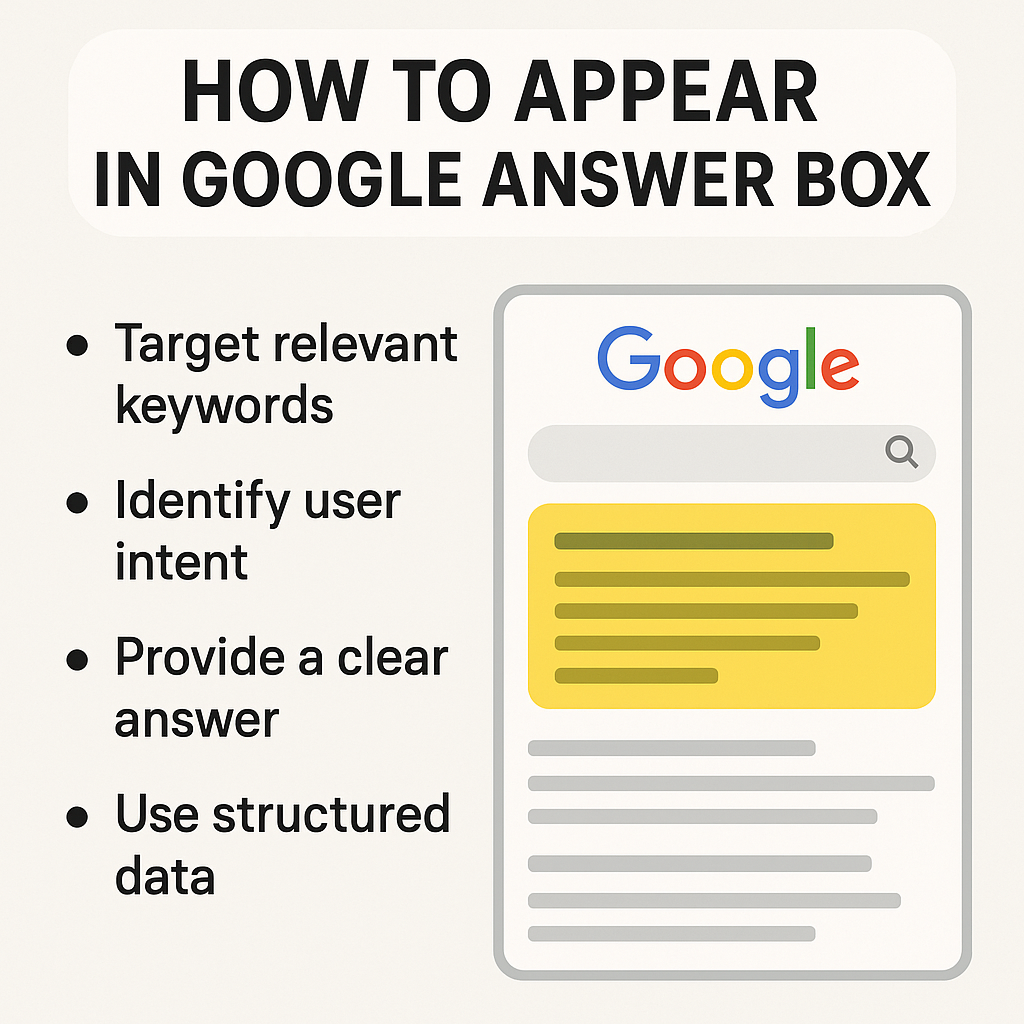
If you’ve ever searched for something on Google and found your question answered right at the top—without even needing to click a website—you’ve seen the Google Answer Box in action. Also known as the Featured Snippet, this high-profile real estate is a powerful traffic magnet. For businesses aiming to boost visibility and credibility online, showing up in the Answer Box is like winning the lottery of organic search. At Speed Dot 360, we help clients optimize their websites for smarter search performance. Appearing in that coveted box requires a combination of technical SEO, strategic content, and the kind of optimization that goes beyond basic keyword stuffing. In fact, our approach blends SEO optimization services, targeted on-page SEO strategies, and well-planned off-page SEO solutions to position content where it matters most—at the very top. But how exactly does your site land there? And what can you do differently to beat your competition to it? Let’s unpack what it takes to own the Answer Box. Understanding How the Google Answer Box Works The Answer Box is designed to quickly provide searchers with concise, accurate information pulled from a relevant web page. Google selects these featured snippets based on how well a piece of content answers a specific query. Rather than being a separate feature you can pay for, it’s entirely earned through search engine trust, structure, and quality. The box can be shown in different formats—paragraphs, lists, tables, or even videos—but the goal is always the same: deliver an immediate answer. Google pulls this data from existing pages in its index, often those that are already ranking on the first page. So the first rule of the Answer Box is this: if your page isn’t already ranking in the top 10, it’s unlikely to be featured. That’s where smart SEO planning enters the scene. Start with Intent-Driven Keyword Research One of the biggest missteps businesses make is targeting the wrong keywords. If your content isn’t aligning with question-based or informational search intent, it’s unlikely to be featured in a snippet. The key is to identify queries people are already asking—and that Google is already answering with a snippet. This is where keyword research services become essential. By using tools like Ahrefs, SEMrush, or even Google’s “People also ask” feature, we can identify opportunities where your content can directly challenge existing featured results. Rather than focusing on high-volume head terms, target long-tail keywords framed as questions. Think along the lines of “how to optimize images for SEO” or “what is responsive web design.” These are the kinds of queries that Google loves to reward with an Answer Box. Content Formatting That Speaks to Google Even the most useful content won’t land in the Answer Box if it’s not formatted in a way that Google can easily understand. This is why page structure is more important than ever. Headers should be used not just for aesthetics but to clearly signal the topic of each section. For example, if your keyword is “how to clean a DSLR camera,” you might include a heading like “Step-by-Step Guide to Cleaning a DSLR Camera” and follow it with a brief paragraph that answers the query concisely. Ideally, your answer should come within the first 100 words of that section, presented in clear, straightforward language. If the content calls for it, include numbered steps or shortlists, but the point is to get to the answer quickly. Google isn’t looking for creative writing—it wants clarity and structure. This is where on-page SEO strategies shine. Proper use of heading tags (H2, H3), schema markup, and accessible formatting make it easier for Google’s crawlers to lift your content and display it in the snippet. Write for Humans, But Optimize for Search Engines Many brands fall into the trap of writing strictly for algorithms. However, the secret to snippet success lies in writing content that performs well for both search engines and human readers. That means being informative without being robotic and educational without overwhelming your audience. The sweet spot lies in a balance: conversational tone, helpful insights, and keyword relevance. Each section of your content should be self-contained enough that it can stand on its own because Google is rarely quoting entire articles. It’s selecting tight excerpts that directly answer a question. If your content meanders, gets buried in long intros or requires scrolling to find an answer, it’s less likely to be considered. That’s why working with a team that provides professional SEO optimization services can help streamline your copy for both performance and readability. Build Authority Beyond the Page It’s easy to forget that off-site signals still influence your chances of earning a featured snippet. While Google doesn’t just hand out Answer Boxes to whoever has the most backlinks, domain authority certainly plays a role. If your website has earned high-quality backlinks, positive brand mentions, and strong engagement signals, you’ll appear more trustworthy to Google’s algorithm. This makes it more likely that your content will be chosen for special features like snippets. This is where off-page SEO solutions come into play. Link-building, guest blogging, digital PR, and consistent citation across the web all contribute to the overall authority of your domain. Think of it this way: Google wants to surface the most reliable source. So even if your content is better structured than a competitor’s, if their domain carries more authority, they’ll probably win the snippet—unless you take steps to even the playing field. Leverage the FAQ Section An often-overlooked tactic is embedding a dedicated FAQ section into your blog posts or landing pages. When you frame questions using headers and immediately answer them below, you’re practically handing Google the content it wants to feature. It also helps you organically target several queries within one page. For example, a blog post on SEO basics might include sub-questions like “What is on-page SEO?” or “Why is keyword research important for SEO?” Each of these can serve as standalone opportunities to appear in Google’s Answer Box. Moreover, incorporating structured data (FAQ




